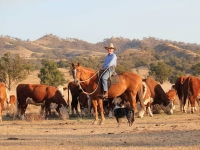Kay Focuses on Hereford Genetics

22 January 2014
NSW beef producer Kay Payne's entire operation is focused on producing strong vigorous calves that will grow into a valuable carcase.
Nothing is left to chance - it's not Kay's way.
Her strong commercial focus was evident when she started a recorded breeding program with her first commercial herd in 1967.
She chose the Hereford breed because of its predominance but her research revealed the power of genetic selection to improve animal performance and so increase returns from a given area.
She obtained an Honours Science Degree which enabled her to expand her understanding and seek out assistance to initiate a planned genetic improvement program for Elite Poll Herefords.Such assistance was readily available at the University of Armidale’s (UNE) Animal Genetics and Breeding Unit (AGBU) under the guidance of Dr Keith Hammond.
Elite Poll Herefords is now run on “Eulalia”, at Gundy, NSW. The property comprises 1,590 ha with the annual rainfall of 600mm and carries a herd of about 360 breeders plus progeny, bulls, steers and replacement females. The undulating country that makes up “Eulalia” consists of native pastures that Kay has over sown with sub clover. The whole area is now well fertilised with super-phosphate and is subject to an ongoing fertiliser program.
The herd is run under challenging conditions at all times. Careful monitoring is carried out for the continued improvement of structure, ease of calving, good growth, temperament, milk, muscle and IMF.
The successful selection for these commercial traits is tested through carcase competitions and feedlot trials. Success in these trials validates the selection program at Elite Poll Herefords and suggests where improvements can be made.
“The uppermost thought in my mind regarding our production goal is that we produce a strong vigorous calf that will grow into a valuable carcase,” Kay says.
Elite Poll Herefords aim to supply several markets. Since the year 2000 they have supplied the EU market. The valuable MSA market plus the short-fed feedlot market are also targeted.
“We are aware of the profit drivers needed for our business and also for our clients,” Kay adds.
There are several profit drivers which Kay divides into “on farm” and “market” profit drivers.
The “on-farm” profit drivers include, before all else, animal soundness then fertility, calving ease and last but not least, good temperament.
The “market” profit drivers include growth for heavy sale weights and good carcase returns, muscling, adequate fat cover and IMF for the markets that are supplied.
Kay uses BREEDPLAN to select for the “on-farm” and the “market” profit drivers.
The use of performance recording and EBV’s can optimise selected traits to meet the needs of seedstock clients and of commercial markets.
“We know what traits are required for our target markets and more importantly how to use these genetic selection tools to produce animals displaying those traits,” Kay says.
BREEDPLAN is one of the most valuable genetic tools that the commercial breeder can take advantage of.
The advice given at the recent Hereford conferences by Dr Rob Banks, Director of AGBU, is that the best place to buy bulls is from the breeders who have strong records with BREEDPLAN and ideally from herds that have made the most progress and shown the best results.
Elite Poll Herefords also uses BREEDPLAN to select for the higher returning MSA market. Genetics that are targeted are those that achieve higher growth for age and better muscling to improve, boning groups, yield, carcase weights and distribution of fat. Intramuscular fat to enhance eating quality is also vital for this market.
Through careful selection, Kay has increased carcase weight by the selection for muscle in conjunction with moderate 600 day weights. This ensures high sale weights but lower mature cow weights and so lower breeder maintenance costs. This is demonstrated by observing Elite Poll Herefords carcase weight trend which shows the herd is 10kg ahead of the overall breed average for carcase weight but only 5kg ahead of the average 600 day weight.
Kay only breeds from females that have a problem free regular calving record.
“Our heifers can successfully calve down 40kg+ progeny, demonstrating that our selection for genetic calving ease and attention to management is working.”
Kay has selected genetics to avoid large increases in birth weights, yet that have growth in at least the top 20 per cent of the breed. In the last ten years the Elite Poll Hereford herd’s birth weight has increased only 0.5kg compared with the overall breeds increase of approximately 1.5kg.
This means commercial breeders benefit with more calves, more weight to sell, so more profit.
Kay’s drive and passion for her herd and the Hereford breed shows no sign of abating, which leaves the beef industry in good stead.
by David Schultz
Published in the Herefords Australia Magazine (Summer 2014)
